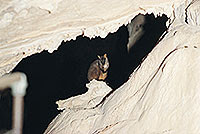The Yass Region has a long history of established settlement, long before the Europeans settled in the region.
Mura Gadi is the name, contributed by Ngunawal/Ngunnawal elder Matilda House and means 'pathways for searching' in the Ngunawal/Ngunnawal language
Prior to 1821, the Yass District had numerous Aboriginal campsites, which reflect a complex aboriginal history within an area which was, prior to European settlement, known as Ngunnawal Territory. The inhabitants of this territory were known as the Ngunnawal tribe. The strong relationship between local indigenous people and the development of the town is reflected in its name, Yass, which is believed derived from an Aboriginal word "Yhar" meaning running water.
The local Yass indigenous members participate in maintaining the Yass River and are currently in the process of removing many pest shrubs and introduced trees - such as 'weeping willows' - which are harmful to the river. When the new concrete Hume Bridge was was constructed to replace the old wooden bridge they contributed several mural which has, by-and-large, deterred local grafitti artists from spoiling the underpasses on the bridge.
The river area is very pictureesque and it is little wonder that the Ngunawal/Ngunnawal people liked it as a camping area.

.JPG)
The first permanent school for Yass was Yass Primary School and was built on the high bank overlooking the Yass River.





.JPG)

.JPG)

.JPG)







.JPG)
.JPG)

.JPG)

.JPG)
.JPG)



.jpg)






